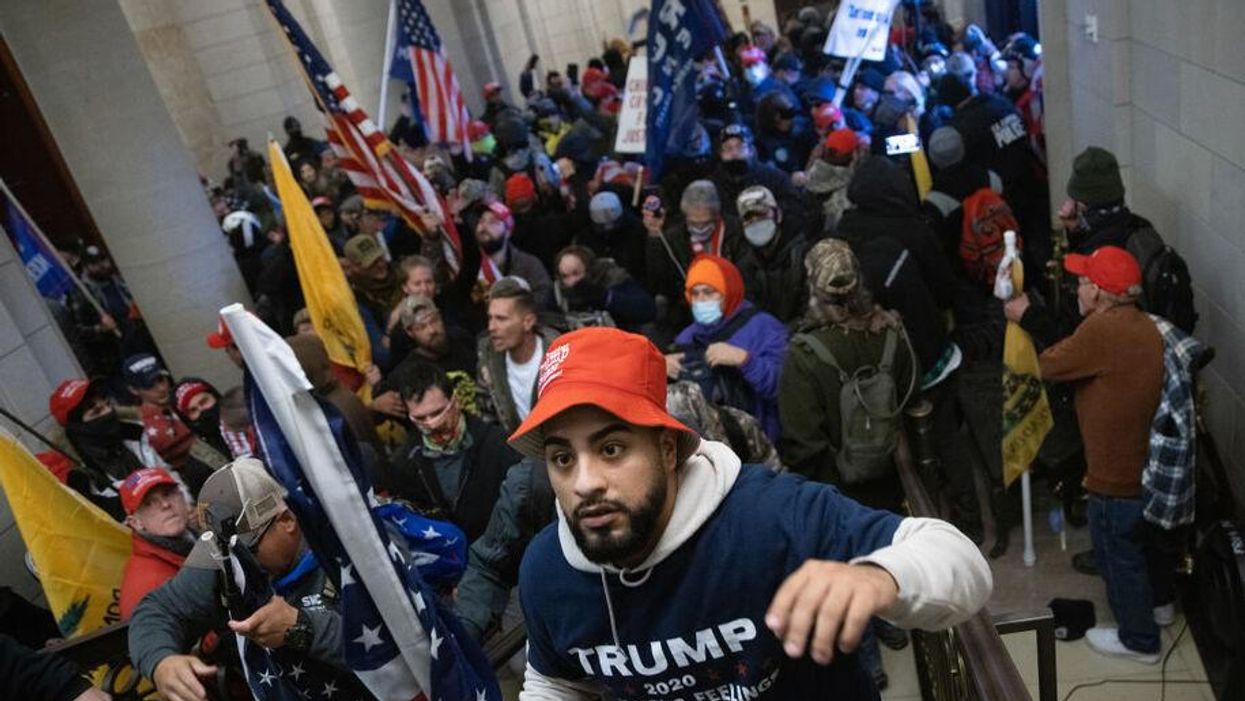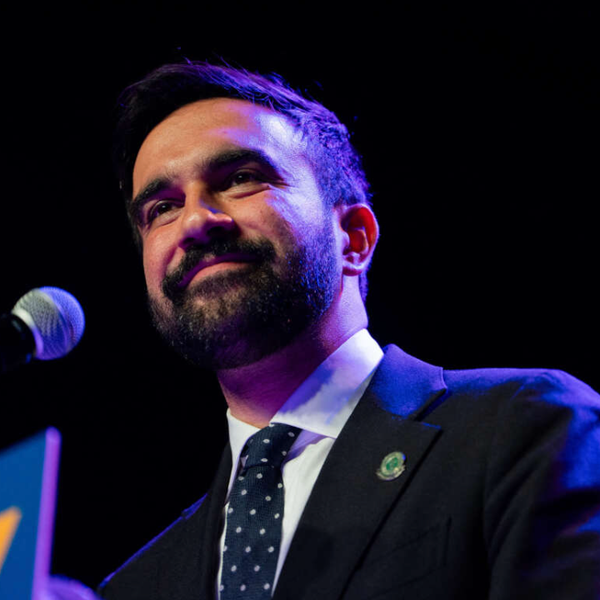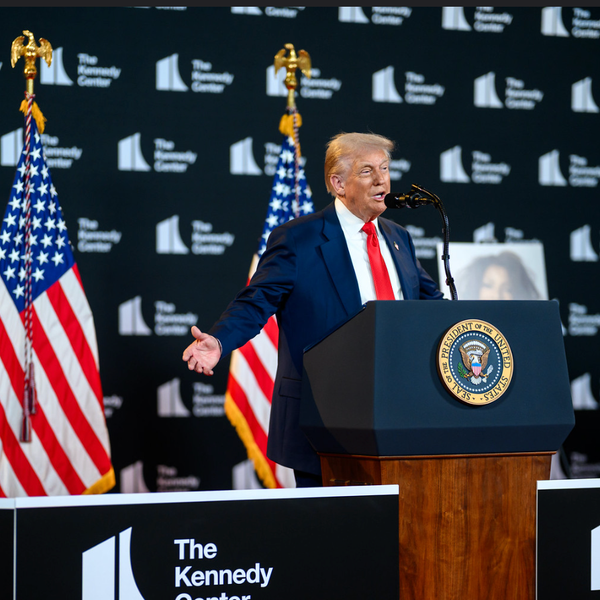Mapping Extremist Networks Shows Capitol Rioters Weren’t ‘Ordinary People'

One of the broad narratives about the January 6, 2021 Capitol insurrection that emerged from demographic assessments of the people subsequently arrested for placing the building and the police guarding it under siege was the general sense that, while organizations like the Oath Keepers and Proud Boys played central roles in the attack, the vast majority of the insurrectionists were just “ordinary citizens” who had no real extremist affiliations but were just swept up in the Trumpian hysteria. It turns out that may not be quite right.
Radicalization expert Michael Jensen compiled a network map of all the people arrested for January 6 crimes—which he originally thought would confirm the “J6 defendants are just ‘ordinary’ people with few links to extremists” conventional wisdom—and found as it kept piling up that he “no longer finds this narrative convincing.” As Marcy Wheeler adroitly observes: “I think people have lost sight of how important organized far right networks were to the riot.”
Jensen, the principal investigator for the Profiles of Individual Radicalization in the United States (PIRUS) project at the University of Maryland’s National Consortium for the Study of Terrorism and Responses to Terrorism (START), compiled the network map from “several thousand pages of court documents and countless social media posts.” He found a total of 244 defendants with extremist connections, and created a visualization of those ties—as well as those between rioters—with the map.
“That’s approximately 30 percent of all defendants. While that’s not a majority, a 30 percent rate of affiliation with extremism/extremist beliefs among a collective of apparently “ordinary” individuals is an astounding number,” Jensen writes on Twitter.
Indeed, while 30 percent still is not a majority, it is not a small minority either. He continues:
Of these 244 defendants, 108 were members of at least one extremist organization. 136 self-identified as members of extremist movements or publicly praised extremist groups and their beliefs. These defendants form nearly 700 dyadic relationships to extremist groups/movements and other defendants with extremist affiliations. These aren’t ordinary relationships—or, at least, they shouldn’t be.
Moreover, the “ordinary people” argument misses what the visualization shows—that J6 involved a number of influential defendants who acted as bridges in a larger network, facilitating the flow harmful ideas from one movement to another. Sure, the J6 defendants are “ordinary” in the sense that most of them have families, neighbors, and jobs, but who really believes that those are the things that distinguish extremists from everyone else?Jensen points to the work of another expert at American University’s Polarization and Extremism Research & Innovation Lab, Cynthia Miller-Idriss, in coming to terms with the reality that far-right extremism has been mainstreamed, and how that has happened, primarily through online radicalization—how “people radicalize in a vast and ever-expanding online ecosystem, a process that often involves no contact with particular organizations”:
Jensen points to the work of another expert at American University’s Polarization and Extremism Research & Innovation Lab, Cynthia Miller-Idriss, in coming to terms with the reality that far-right extremism has been mainstreamed, and how that has happened, primarily through online radicalization—how “people radicalize in a vast and ever-expanding online ecosystem, a process that often involves no contact with particular organizations”:
As ordinary individuals encounter these ideas, whether through custom-tailored propaganda or through more grassroots efforts amplified by social media, they assemble them into their own personalized belief systems. This is a far cry from more traditional models of radicalization in which people gradually adopt an identifiable group’s ideological framework—such as fascism or neo-Nazism—that calls for violent solutions against a common enemy. These more coherent processes involve initiation rites, manifestos, leaders, and a chain of command that guide beliefs and actions. Those elements are largely absent from today’s patchwork, choose-your-own-adventure mode of radicalization.
Miller-Idriss’s point is that “Extremism has gone mainstream; so must the interventions needed to address it.” And as Jensen observes, it’s likely that the “ordinary people” narrative surrounding J6 only makes this problem worse.
“It depicts aligning with extremist groups, even if indirectly, and/or adopting their beliefs and attempting to violently end democracy as something “ordinary” people do,” he writes. “It’s not.”
Heidi Beirich, the longtime intelligence director at the Southern Poverty Law Center now with the Global Project Against Hate and Extremism, explains that this radicalization has been openly encouraged by Republican officeholders and a broad array of right-wing pundits, who have promoted white-nationalist and other far-right conspiracy theories into the mainstream of public discourse, ranging from the racist “Great Replacement” theory claiming that liberals are deliberately seeking to displace white voters with a tide of nonwhite immigration and civil rights, to the contradictory claims that “leftists” and “antifa” were actually responsible for the January 6 violence and that the rioters simultaneously righteous “patriots” seeking to defend the nation from a communist takeover.
Beirich cites a recent University of Chicago Project on Security and Threats report identifying an active American insurrectionist movement comprising some 21 million people. These radicalized Trump followers believe that “Use of force is justified to restore Donald J. Trump to the presidency” and that “The 2020 election was stolen, and Joe Biden is an illegitimate president.” About 63 percent of them believe in the Great Replacement theory, while 54 percent subscribe to far-right QAnon conspiracism.
It also notes that this insurrectionist movement is made up of “mainly highly competent, middle-aged American professionals,” leading the researchers to warn that their continuing radicalization “does not bode well for the 2022 midterm elections, or for that matter, the 2024 Presidential election.”
Marcy Wheeler notes that Jensen’s map reveals how massive an influence QAnon networks were in fueling the insurrection. She observes “how much more effective QAnon was at getting bodies where they needed them than the militias (the Proud Boys were busy moving other bodies around). Note how many QAnoners there are here.”
Moreover, as she explains, the map gives weight to the reportage this week by The New York Times’ Alan Feuer, revealing the key role that a Roger Stone minion and QAnon influencer named Jason Sullivan had in fomenting the January 6 violence:
More recently, Mr. Sullivan has taken an active role in promoting the QAnon conspiracy theory, which holds that prominent liberals belong to a cult of Satan-worshipping pedophiles. At a public appearance last year with Ms. Powell and Mr. Flynn, Mr. Sullivan called Hillary Clinton a “godawful woman” and then made a gesture suggesting she should be hanged.
On the conference call ahead of Jan. 6, Mr. Sullivan told his listeners that he was an expert at making things go viral online, but that it was not enough to simply spread the message that the election had been stolen.
“There has to be a multiple-front strategy, and that multiple-front strategy, I do think, is descend on the Capitol, without question,” he said. “Make those people feel it inside.”
As Wheeler says: “If someone can be shown to have triggered the QAnoners, it is an important detail. FBI was investigating this within weeks after the riot.”
Reprinted with permission from Daily Kos









